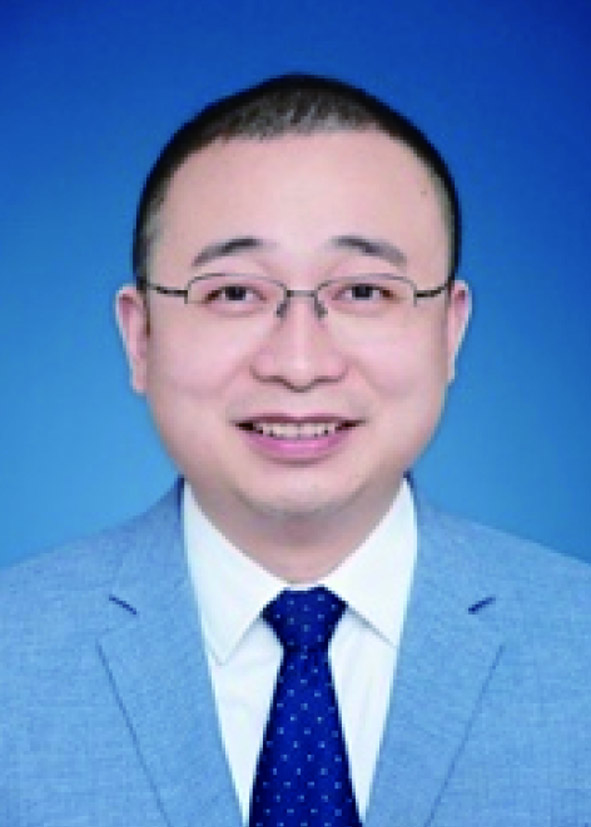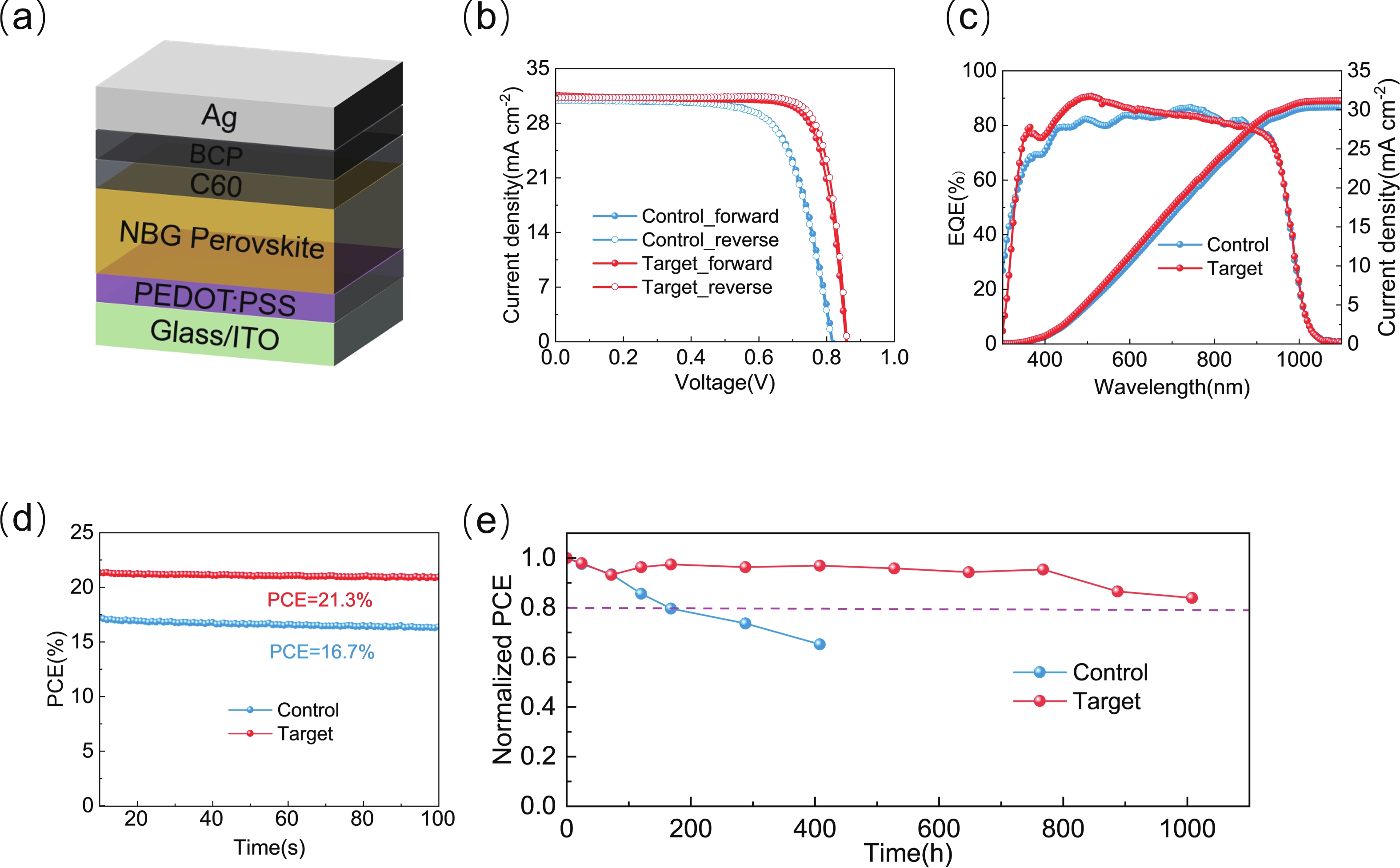| Citation: |
Jianhua Zhang, Xufeng Liao, Weisheng Li, Yutian Tian, Qinyang Huang, Yitong Ji, Guotang Hu, Qingguo Du, Wenchao Huang, Donghoe Kim, Yi-Bing Cheng, Jinhui Tong. Minimizing tin (Ⅱ) oxidation using ethylhydrazine oxalate for high-performance all-perovskite tandem solar cells[J]. Journal of Semiconductors, 2025, 46(5): 052802. doi: 10.1088/1674-4926/24120026
****
J H Zhang, X F Liao, W S Li, Y T Tian, Q Y Huang, Y T Ji, G T Hu, Q G Du, W C Huang, D Kim, Y B Cheng, and J H Tong, Minimizing tin (Ⅱ) oxidation using ethylhydrazine oxalate for high-performance all-perovskite tandem solar cells[J]. J. Semicond., 2025, 46(5), 052802 doi: 10.1088/1674-4926/24120026
|
Minimizing tin (Ⅱ) oxidation using ethylhydrazine oxalate for high-performance all-perovskite tandem solar cells
DOI: 10.1088/1674-4926/24120026
CSTR: 32376.14.1674-4926.24120026
More Information-
Abstract
All-perovskite tandem solar cells (ATSCs) have the potential to surpass the Shockley−Queisser efficiency limit of conventional single-junction devices. However, the performance and stability of mixed tin–lead (Sn–Pb) perovskite solar cells (PSCs), which are crucial components of ATSCs, are much lower than those of lead-based perovskites. The primary challenges include the high crystallization rate of perovskite materials and the susceptibility of Sn2+ oxidation, which leads to rough morphology and unfavorable p-type self-doping. To address these issues, we introduced ethylhydrazine oxalate (EDO) at the perovskite interface, which effectively inhibits the oxidation of Sn2+ and simultaneously enhances the crystallinity of the perovskite. Consequently, the EDO-modified mixed tin−lead PSCs reached a power conversion efficiency (PCE) of 21.96% with high reproducibility. We further achieved a 27.58% efficient ATSCs by using EDO as interfacial passivator in the Sn−Pb PSCs. -
References
[1] Sutherland B R, Sargent E H. Perovskite photonic sources. Nat Photonics, 2016, 10, 295 doi: 10.1038/nphoton.2016.62[2] Tu Q, Spanopoulos I, Hao S Q, et al. Out-of-plane mechanical properties of 2D hybrid organic-inorganic perovskites by nanoindentation. ACS Appl Mater Interfaces, 2018, 10(26), 22167 doi: 10.1021/acsami.8b05138[3] Lee J W, Lee D K, Jeong D N, et al. Control of crystal growth toward scalable fabrication of perovskite solar cells. Adv Funct Materials, 2019, 29(47), 1807047 doi: 10.1002/adfm.201807047[4] Zhao D W, Yu Y, Wang C L, et al. Low-bandgap mixed tin–lead iodide perovskite absorbers with long carrier lifetimes for all-perovskite tandem solar cells. Nat Energy, 2017, 2(4), 17018 doi: 10.1038/nenergy.2017.18[5] Best research−cell efficiency chart. Available from: https://www.nrel.gov/pv/cell−efficiency.html.[6] Shockley W, Queisser H J. Detailed balance limit of efficiency of p-n junction solar cells. J Appl Phys, 1961, 32(3), 510 doi: 10.1063/1.1736034[7] Hu M Y, Chen M, Guo P J, et al. Sub-1.4eV bandgap inorganic perovskite solar cells with long-term stability. Nat Commun, 2020, 11(1), 151 doi: 10.1038/s41467-019-13908-6[8] Sha W, Ren X G, Chen L Z, et al. The efficiency limit of CH3NH3PbI3 perovskite solar cells. Appl Phys Lett, 2015, 106(22), 221104 doi: 10.1063/1.4922150[9] Zhou S, Fu S Q, Wang C, et al. Aspartate all-in-one doping strategy enables efficient all-perovskite tandems. Nature, 2023, 624(7990), 69 doi: 10.1038/s41586-023-06707-z[10] He R, Wang W H, Yi Z J, et al. Improving interface quality for 1-cm2 all-perovskite tandem solar cells. Nature, 2023, 618(7963), 80 doi: 10.1038/s41586-023-05992-y[11] Yu D N, Pan M L, Liu G Q, et al. Electron-withdrawing organic ligand for high-efficiency all-perovskite tandem solar cells. Nat Energy, 2024, 9, 298 doi: 10.1038/s41560-023-01441-2[12] Gu S, Lin R X, Han Q L, et al. Tin and mixed lead-tin halide perovskite solar cells: Progress and their application in tandem solar cells. Adv Mater, 2020, 32(27), e1907392 doi: 10.1002/adma.201907392[13] Zhang Z H, Huang Y F, Jin J L, et al. Mechanistic understanding of oxidation of tin-based perovskite solar cells and mitigation strategies. Angew Chem Int Ed, 2023, 62(45), e202308093 doi: 10.1002/anie.202308093[14] Yoo J J, Seo G, Chua M R, et al. Efficient perovskite solar cells via improved carrier management. Nature, 2021, 590(7847), 587 doi: 10.1038/s41586-021-03285-w[15] Xiao K, Lin R X, Han Q L, et al. All-perovskite tandem solar cells with 24.2% certified efficiency and area over 1 cm2 using surface-anchoring zwitterionic antioxidant. Nat Energy, 2020, 5, 870 doi: 10.1038/s41560-020-00705-5[16] Qin M C, Chan P F, Lu X H. A systematic review of metal halide perovskite crystallization and film formation mechanism unveiled by in situ GIWAXS. Adv Mater, 2021, 33(51), 2105290 doi: 10.1002/adma.202105290[17] Li B, Chang B H, Pan L, et al. Tin-based defects and passivation strategies in tin-related perovskite solar cells. ACS Energy Lett, 2020, 5(12), 3752 doi: 10.1021/acsenergylett.0c01796[18] Wang F, Ma J L, Xie F Y, et al. Organic cation-dependent degradation mechanism of organotin halide perovskites. Adv Funct Mater, 2016, 26(20), 3417 doi: 10.1002/adfm.201505127[19] Kapil G, Bessho T, Ng C H, et al. Strain relaxation and light management in tin–lead perovskite solar cells to achieve high efficiencies. ACS Energy Lett, 2019, 4(8), 1991 doi: 10.1021/acsenergylett.9b01237[20] Lv S S, Gao W Y, Liu Y H, et al. Stability of Sn-Pb mixed organic–inorganic halide perovskite solar cells: Progress, challenges, and perspectives. J Energy Chem, 2022, 65, 371 doi: 10.1016/j.jechem.2021.06.011[21] Lin R X, Xiao K, Qin Z Y, et al. Monolithic all-perovskite tandem solar cells with 24.8% efficiency exploiting comproportionation to suppress Sn(ii) oxidation in precursor ink. Nat Energy, 2019, 4, 864 doi: 10.1038/s41560-019-0466-3[22] Zong Y X, Zhou Z M, Chen M, et al. Lewis-adduct mediated grain-boundary functionalization for efficient ideal-bandgap perovskite solar cells with superior stability. Adv Energy Mater, 2018, 8(27), 1800997 doi: 10.1002/aenm.201800997[23] Wang J T, Uddin M A, Chen B, et al. Enhancing photostability of Sn-Pb perovskite solar cells by an alkylammonium pseudo-halogen additive. Adv Energy Mater, 2023, 13(15), 2204115 doi: 10.1002/aenm.202204115[24] Hu S F, Otsuka K, Murdey R, et al. Optimized carrier extraction at interfaces for 23.6% efficient tin–lead perovskite solar cells. Energy Environ Sci, 2022, 15(5), 2096 doi: 10.1039/D2EE00288D[25] Wei M Y, Xiao K, Tan H R, et al. Combining efficiency and stability in mixed tin-lead perovskite solar cells by capping grains with an ultra-thin 2D layer. Adv Mater, 2020, 32(12), 1907058 doi: 10.1002/adma.201907058[26] Kapil G, Bessho T, Maekawa T, et al. Tin-lead perovskite fabricated via ethylenediamine interlayer guides to the solar cell efficiency of 21.74%. Adv Energy Mater, 2021, 11(25), 2101069 doi: 10.1002/aenm.202101069[27] Li X, Chen C C, Cai M L, et al. Efficient passivation of hybrid perovskite solar cells using organic dyes with –COOH functional group. Adv Energy Mater, 2018, 8(20), 1800715 doi: 10.1002/aenm.201800715[28] Liu H, Wang L X, Li R J, et al. Modulated crystallization and reduced VOC deficit of mixed lead–tin perovskite solar cells with antioxidant caffeic acid. ACS Energy Lett, 2021, 6(8), 2907 doi: 10.1021/acsenergylett.1c01217[29] Xing Y J, Xiong J X, Wang Q X, et al. Selection of phenyl hydrazine derivatives as an Sn4+ reductant for tin–lead perovskite solar cells. J Mater Chem C, 2024, 12(28), 10585 doi: 10.1039/D4TC00719K[30] Cao J P, Loi H L, Xu Y, et al. High-performance tin-lead mixed-perovskite solar cells with vertical compositional gradient. Adv Mater, 2022, 34(6), e2107729 doi: 10.1002/adma.202107729[31] Bergmann V W, Weber S A L, Javier Ramos F, et al. Real-space observation of unbalanced charge distribution inside a perovskite-sensitized solar cell. Nat Commun, 2014, 5, 5001 doi: 10.1038/ncomms6001[32] Ogomi Y, Morita A, Tsukamoto S, et al. CH3NH3SnxPb(1-x)I3 perovskite solar cells covering up to 1060 nm. J Phys Chem Lett, 2014, 5(6), 1004 doi: 10.1021/jz5002117[33] Ye S Y, Rao H X, Zhao Z R, et al. A breakthrough efficiency of 19.9% obtained in inverted perovskite solar cells by using an efficient trap state passivator Cu(thiourea)I. J Am Chem Soc, 2017, 139(22), 7504 doi: 10.1021/jacs.7b01439[34] Chen W J, Liu S, Li Q Q, et al. High-polarizability organic ferroelectric materials doping for enhancing the built-In electric field of perovskite solar cells realizing efficiency over 24%. Adv Mater, 2022, 34(14), 2110482 doi: 10.1002/adma.202110482[35] Shen W C, Fang H Y, Pu D X, et al. Optimizing blade-coated tin–lead perovskite solar cells and tandems with multi-carboxyl and amino group integration. Adv Funct Mater, 2024, 34(52), 2410605 doi: 10.1002/adfm.202410605[36] Shen W C, Azmy A, Li G, et al. A crystalline 2D fullerene-based metal halide semiconductor for efficient and stable ideal-bandgap perovskite solar cells. Adv Energy Mater, 2024, 14(23), 2400582 doi: 10.1002/aenm.202400582[37] Le Corre V M, Duijnstee E A, El Tambouli O, et al. Revealing charge carrier mobility and defect densities in metal halide perovskites via space-charge-limited current measurements. ACS Energy Lett, 2021, 6(3), 1087 doi: 10.1021/acsenergylett.0c02599[38] Zhang W J, Huang L S, Guan H L, et al. Bottom-up modification boosts the performance of narrow-bandgap lead–tin perovskite single-junction and tandem solar cells. Energy Environ Sci, 2023, 16(12), 5852 doi: 10.1039/D3EE02010J[39] Zhang S S, Hosseini S M, Gunder R, et al. The role of bulk and interface recombination in high-efficiency low-dimensional perovskite solar cells. Adv Mater, 2019, 31(30), e1901090 doi: 10.1002/adma.201901090 -
Supplements
 24120026Supporting_Information.pdf
24120026Supporting_Information.pdf

-
Proportional views





 Jianhua Zhang received his bachelor's degree from Chongqing University of Technology in 2021. Now he is a master student in the College of Materials Science and Engineering at Wuhan University of Technology. His research focuses on the research and fabrication of Pb−Sn perovskite solar cells.
Jianhua Zhang received his bachelor's degree from Chongqing University of Technology in 2021. Now he is a master student in the College of Materials Science and Engineering at Wuhan University of Technology. His research focuses on the research and fabrication of Pb−Sn perovskite solar cells. Jinhui Tong is currently a professor in State Key Lab of Advanced Technology for Materials Synthesis and Processing, Wuhan University of Technology. He obtained his PhD degree from Huazhong University of Science and Technology, China, in 2018. He was a Postdoctoral Researcher in the Chemistry and Nanoscience Center at the National Renewable Energy Laboratory (NREL) from 2018 to 2021. His research interest is developing perovskite materials and solar cells.
Jinhui Tong is currently a professor in State Key Lab of Advanced Technology for Materials Synthesis and Processing, Wuhan University of Technology. He obtained his PhD degree from Huazhong University of Science and Technology, China, in 2018. He was a Postdoctoral Researcher in the Chemistry and Nanoscience Center at the National Renewable Energy Laboratory (NREL) from 2018 to 2021. His research interest is developing perovskite materials and solar cells.
 DownLoad:
DownLoad:




















